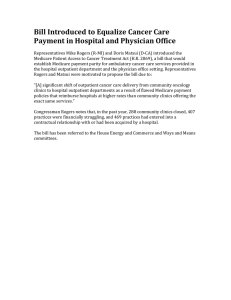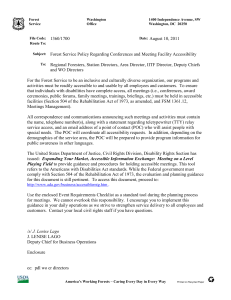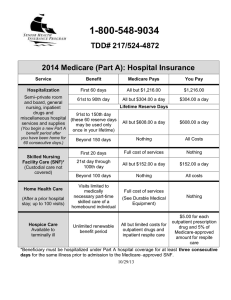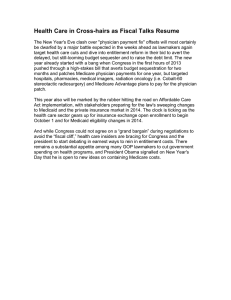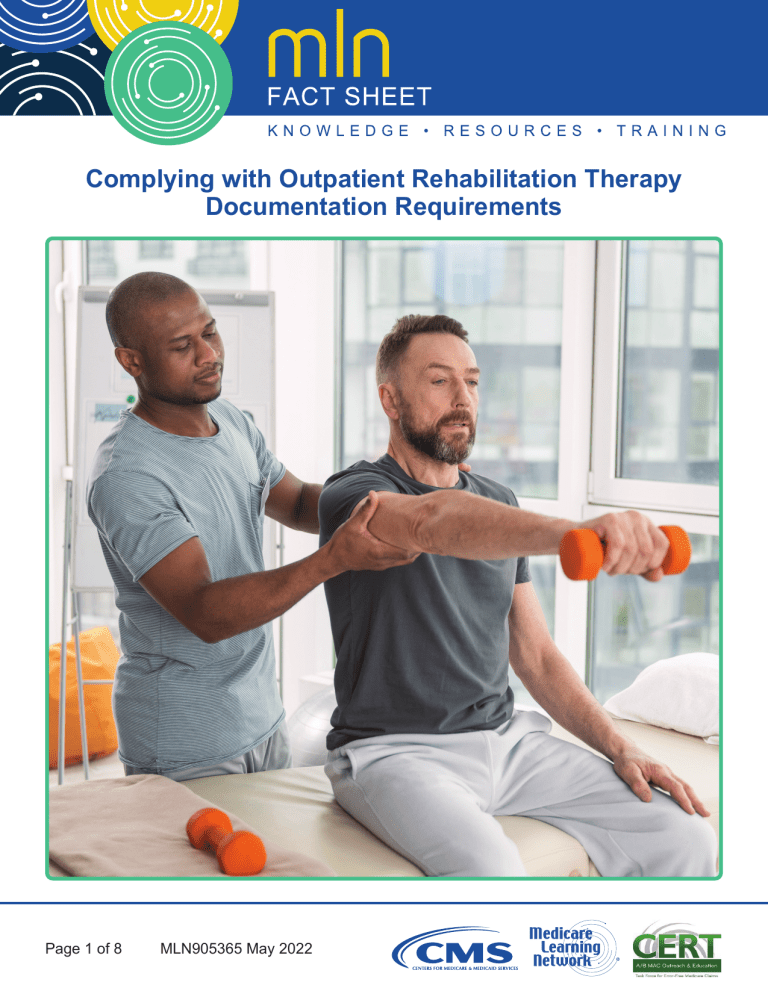
Complying with Outpatient Rehabilitation Therapy Documentation Requirements Page 1 of 8 MLN905365 May 2022 Complying with Outpatient Rehabilitation Therapy Documentation Requirements What’s Changed? CMS created 2 new therapy assistant service modifiers (page 7). You’ll find substantive content updates in dark red font. Page 2 of 8 MLN905365 May 2022 MLN Fact Sheet Complying with Outpatient Rehabilitation Therapy Documentation Requirements MLN Fact Sheet This fact sheet was collaboratively developed by the Medicare Learning Network® (MLN) and the Comprehensive Error Rate Testing (CERT) Part A and Part B (A/B) Medicare Administrative Contractor (MAC) Outreach & Education Task Forces to provide nationally-consistent education on topics of interest to health care providers. In this fact sheet, “we” refers to CMS and “you” refers to the provider or supplier. In this fact sheet we’ll discuss: ● Common outpatient rehabilitation therapy services’ CERT errors ● Medicare outpatient rehabilitation therapy documentation requirements The CERT Program measures improper payments in the Medicare Fee-for-Service (FFS) Program and selects a random sample of Medicare FFS claims for review to determine if they were properly paid under Medicare coverage, coding, and billing rules. Visit the CERT webpage for more information. Billing Part B Outpatient Therapy Services Outpatient rehabilitation therapy includes Physical Therapy (PT), Occupational Therapy (OT), and Speech-Language Pathology (SLP) services. Medicare covers outpatient PT, OT, and SLP services when: ● Physician or Non-Physician Practitioner (NPP) certifies the “treatment plan,” called the Plan of Care (POC), ensuring: ● Patient needs therapy services ● POC is: ▪ ▪ ● Established by a physician, NPP, or qualified therapist providing services Reviewed periodically by a physician or NPP Patient gets services under physician care ● POC certifying provider’s name and NPI is on the claim ● Providers meet medical necessity, documentation, and coding requirements Page 3 of 8 MLN905365 May 2022 Definitions Physician is a Doctor of Medicine, osteopathy, podiatric medicine, optometry (only for low vision rehabilitation). NPP is a Physician Assistant (PA), Clinical Nurse Specialist (CNS), or Nurse Practitioner (NP). Qualified Therapist includes a PT, OT, or SLP who meets regulatory qualifications as applicable, including state licensure or certification. Sections 230.1–230.3 of Medicare Benefit Policy Manual Chapter 15 has more information. Complying with Outpatient Rehabilitation Therapy Documentation Requirements MLN Fact Sheet Common Outpatient Rehabilitation Therapy CERT Errors Error Missing certification and recertification(s): Physician’s, NPP’s, or therapist’s dated signature(s) approving the POC Missing signature: Physician, NPP, or therapist who developed the POC and established treatment plan date Missing or incomplete POC Missing significant POC changes: Certifications and recertification(s) Missing total time: For timed procedures and total active treatment time Missing or incomplete initial evaluation Prevention Confirm physician or NPP certified the POC (and recertified it when appropriate) with their signature and date Ensure you add your dated signature and professional identification (for example, PT, OT) Create a complete POC that includes diagnoses, long-term goals, type, amount, frequency, and service(s) duration Certify a significantly modified POC (physician or NPP signs and dates it) Clearly document in 15-minute timed codes the total treatment time to support number of units and codes billed for each treatment day; document total active treatment time (including timed and untimed codes) in the patient’s medical record Document initial evaluation with your signature, professional identification (for example, PT, OT) and date you made the initial evaluation (see section 220.3 of Medicare Benefit Policy Manual, Chapter 15 for more information) Missing or incomplete progress reports Progress reports justify medical necessity and require information such as timing (at least once every 10 treatment days) and should include your signature, professional identification, and date (see section 220.3 of Medicare Benefit Policy Manual, Chapter 15 for more information) Missing elements supporting medical necessity See sections 220 and 230 of Medicare Benefit Policy Manual, Chapter 15 for more information Note: If your MAC identifies a potential outpatient therapy Part B claim overpayment within 6 years of receiving the overpayment (generally referred to as the “look back period”), the provider must report and return all identified overpayments. See section 1128J(d) of the Social Security Act for more information. Page 4 of 8 MLN905365 May 2022 Complying with Outpatient Rehabilitation Therapy Documentation Requirements MLN Fact Sheet Outpatient Rehabilitation Therapy Services Documentation Written POC The services must relate directly and specifically to a written treatment plan (also known as a POC or plan of treatment). You must establish the POC before treatment begins, with some exceptions. A physician, PT, OT, SLP, or an NPP may develop (written or dictated) a POC. Only a physician may establish a POC in a Comprehensive Outpatient Rehabilitation Facility (CORF). At a minimum, the POC must have: ● Diagnoses ● Long-term treatment goals ● Rehabilitation therapy service types: PT, OT, or SLP, when appropriate ● Describe type as a specific treatment or intervention type ● Therapy amount: Number of treatment sessions per day ● Therapy frequency: Number of treatment sessions per week ● Therapy duration: Total number of weeks or treatment sessions Include the signature and professional identity of the person who established the POC and the date it was established. Document the physician’s or NPP’s written or verbal approval, and any significant or long-term goal change (for example, the physician or NPP treating a new condition) to the already certified POC. Each POC should offer the most effective and efficient treatment and balance appropriate resources to provide the best possible outcomes. Page 5 of 8 MLN905365 May 2022 Complying with Outpatient Rehabilitation Therapy Documentation Requirements MLN Fact Sheet Initial POC Certification The physician’s or NPP’s signature and date on a correctly written POC, with or without an order, satisfies the certification requirement during the POC or 90 calendar days from the initial treatment date, whichever is less. Include the initial evaluation indicating the POC treatment need. The physician or NPP certifies the initial POC with a dated signature or verbal order within 30 days from the first day of treatment, including evaluation. The physician or NPP must sign and date verbal orders within 14 days. Recertification Sign recertifications, documenting the need for continued or modified therapy whenever a significant POC modification becomes evident or at least every 90 days after treatment starts. Complete recertification sooner when the plan duration is less than 90 days unless a certification delay occurs. We allow delayed certification when the physician or NPP completes certification and includes a delay reason. We accept certifications without justification up to 30 days after the due date. Recertification is timely when dated during initial POC or within 90 calendar days of initial POC, whichever is less. Billing Procedure Units When reporting “untimed service units” HCPCS codes (procedure is undefined by specific time frame), report 1 in the unit field (for example, therapy evaluations, group therapy, and supervised modalities HCPCS codes). We define some 15-minute patient contact HCPCS codes as direct (1-on-1) time spent in patient contact. The number of units for these timed codes reported per discipline for each date, regardless of the number of different treatments provided, is determined by total timed codes treatment time. Document total minutes under timed codes in the patient’s medical record for each service date to support the number of units and codes billed. Also, report total active treatment service minutes, including timed and untimed procedures or modalities. Page 6 of 8 MLN905365 May 2022 Therapy Modifier Requirements All outpatient therapy service claims must report a therapy modifier (GP, GO, or GN) with the HCPCS code to show the treatment plan discipline (PT, OT, or SLP). Certain HCPCS codes require certain therapy modifiers. Complying with Outpatient Rehabilitation Therapy Documentation Requirements MLN Fact Sheet In 2019, we created 2 new therapy assistant services modifiers: ● CQ Modifier: Outpatient physical therapy services furnished, in whole or in part, by a physical therapist assistant ● CO Modifier: Outpatient occupational therapy services furnished, in whole or in part, by an occupational therapy assistant As of January 1, 2020, each outpatient therapy services claim, in whole or in part, must include these modifiers for Occupational Therapy Assistant (OTA) or Physical Therapy Assistant (PTA) services. See Reduced Payment for PT and OT Services Furnished In Whole or In Part by a PTA or OTA for more information. We allow providers to bill a 15-minute timed service without the CQ and CO modifier when a PTA and OTA provides patient care, independent from the PT or OT. The PT or OT must meet Medicare timed service billing requirements and not include independent PTA or OTA minutes. They must provide more than the 15-minutes midpoint (that is, 8 minutes or more—also known as the 8-minute rule). Any minutes the PTA or OTA provides in these situations doesn’t matter for Medicare billing purposes. We allow providers to bill a 15-minute unit with the CQ or CO modifier and 1, 15-minute unit without the CQ or CO modifier in billing situations where there’s 2, 15-minute units left to bill when the PT or OT and the PTA or OTA each provide 9–14 minutes of the same service when the total time is at least 23 minutes and no more than 28 minutes. Correctly Using Timed & Untimed Codes When you provide only 1, 15-minute timed HCPCS code per day, we don’t allow billing of that service if you did it for less than 8 minutes. When providing more than 1 unit of service, the initial and subsequent service must each total at least 15 minutes, and the last unit may count as a full-service unit if it has at least 8 minutes of additional services. Don’t count all treatment minutes per day to 1 HCPCS code if more than 15 minutes of 1, or you provided other services. If a therapist provides 4 distinct, separate 8-minute treatments (32 treatment minutes total), don’t report 4, 15-minute treatment units on the claim. In this case, you may report only 2 units (at least 23 minutes but less than 38 minutes). You may report a third unit when you provide a total of 38–52 minutes; and you may bill a fourth unit if you provide at least 53 but less than 68 treatment minutes. Don’t report units on the claim that exceed the total timed codes’ treatment minutes. If you report both timed and untimed codes on the same claim, don’t count time spent on untimed-code services toward the timed-code services. Section 20.2 of Medicare Claims Processing Manual, Chapter 5 has more information about HCPCS coding requirements, including examples correctly showing 15-minute codes when providing 1 or multiple therapy services, procedures, and or modalities per day. Page 7 of 8 MLN905365 May 2022 Complying with Outpatient Rehabilitation Therapy Documentation Requirements MLN Fact Sheet Resources ● Local Coverage Determinations ● Medicare Program Integrity Manual, Chapter 12 ● Medicare Benefit Policy Manual, Chapter 12, sections 20 and 30 ● Medicare General Information, Eligibility, and Entitlement Manual, Chapter 5, section 10.3 ● Medicare Program Integrity Manual, Chapter 3, section 3.3.2.4 The Comprehensive Error Rate Testing (CERT) Part A and Part B (A/B) and Durable Medical Equipment (DME) Medicare Administrative Contractor (MAC) Outreach & Education Task Forces are independent from the Centers for Medicare & Medicaid Services (CMS) CERT team and CERT contractors. Medicare Learning Network® Content Disclaimer, Product Disclaimer, and Department of Health & Human Services Disclosure The Medicare Learning Network®, MLN Connects®, and MLN Matters® are registered trademarks of the U.S. Department of Health & Human Services (HHS). Page 8 of 8 MLN905365 May 2022
